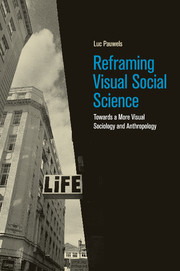Book contents
- Reframing Visual Social Science
- Reframing Visual Social Science
- Copyright page
- Dedication
- Contents
- Figures
- Part I Remodeling visual social science
- Part II The visual researcher as collector and interpreter
- Part III The visual researcher as producer, facilitator and communicator
- 5 The mimetic mode: from exploratory to systematic visual data production
- 6 Visual elicitation techniques, respondent-generated image production and ‘participatory’ visual activism
- 7 The ‘visual essay’ as a scholarly format: art meets (social) science?
- 8 Social scientific filmmaking and multimedia production: key features and debates
- Part IV Applications / case studies
- Part V Visual research in a wider perspective
- Index
- References
5 - The mimetic mode: from exploratory to systematic visual data production
from Part III - The visual researcher as producer, facilitator and communicator
Published online by Cambridge University Press: 05 September 2015
- Reframing Visual Social Science
- Reframing Visual Social Science
- Copyright page
- Dedication
- Contents
- Figures
- Part I Remodeling visual social science
- Part II The visual researcher as collector and interpreter
- Part III The visual researcher as producer, facilitator and communicator
- 5 The mimetic mode: from exploratory to systematic visual data production
- 6 Visual elicitation techniques, respondent-generated image production and ‘participatory’ visual activism
- 7 The ‘visual essay’ as a scholarly format: art meets (social) science?
- 8 Social scientific filmmaking and multimedia production: key features and debates
- Part IV Applications / case studies
- Part V Visual research in a wider perspective
- Index
- References
Information
- Type
- Chapter
- Information
- Reframing Visual Social ScienceTowards a More Visual Sociology and Anthropology, pp. 97 - 116Publisher: Cambridge University PressPrint publication year: 2015
